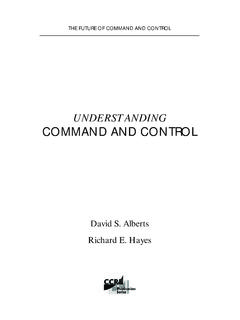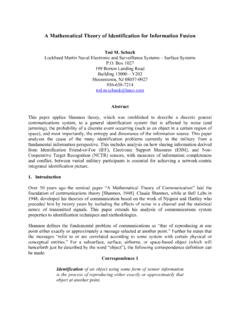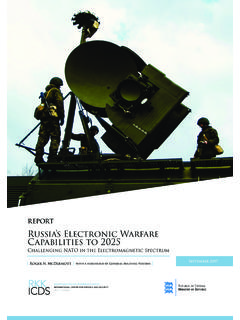Transcription of Shock and Awe - dodccrp.org
1 Shock and Awe Achieving Rapid Dominance By: Harlan K. Ullman and James P. Wade With: Bud Edney Fred M. Franks Charles A. Horner Jonathan T. Howe Keith Brendley, Executive Secretary Prepared by Defense Group Inc. for The National Defense University Table of Contents v vii Introduction to Rapid xvii Chapter One: Background and 1. Chapter Two: Shock and 19. Chapter Three: Strategic, Policy, and Operational Application .. 37. Chapter Four: An Outline for System Innovation and Technological 65. Chapter Five: Future 91. Appendices Views of Three Former Unified CINCs Appendix A: Thoughts on Rapid Dominance . by Admiral Bud Edney .. 99. Appendix B: Defense Alternatives: Forces Required . by General Chuck 117. Appendix C: Enduring Realities and Rapid Dominance . by General Fred Franks .. 135. Biographies of the Study Group Members .. 141. iii Foreword W e are in the early stages of what promises to be an extended debate about the future of conflict and the future of our defense establishment.
2 Few will deny that the winds of change are blowing as never before, driven by a radically altered geopolitical situation, an evolv- ing information-oriented society, advancing tech- nology, and budgetary constraints. How our nation responds to the challenge of change will determine our ability to shape the future and defend ourselves against 21st century threats. The major issue, however it may be manifested, involves the degree of change that is required. Advocates, all along the spectrum from a military technical revolution to a revolution in military affairs to a revolution in security affairs, are making their cases. Military institutions are by their very nature somewhat conservative. History has shown that success has often sown the seeds of future failure. We as a nation can ill afford to follow in the footsteps of those who have rested on their laurels and failed to stretch their imagi- nations. v Often, those who are the most knowledgeable and experienced about a subject are not in the most advantageous position to understand a new world order.
3 Yet these same individuals are often among the most credible voices and therefore are essen- tial to progress. The authors of Shock and Awe are a highly accomplished and distinguished group with the credibility that comes from years of front line experience. Thus, this work is important not only because of the ideas contained within, but because of the caliber and credibility of the authors. ACTIS seeks to articulate and explore advanced concepts. In sponsoring this work and in disseminating its initial results, we hope to contribute to the ongoing dialogue about alternatives, their promises, and their risks. As the authors note, this is a work in progress meant not to provide definitive solutions but a pro- posed perspective for considering future security needs and strategies. To the extent that vigorous debate ensues we will be successful. David S. Alberts Washington, October 1996. vi Prologue T he purpose of this paper is to explore alter- native concepts for structuring mission capability packages (MCP's) around which future U.
4 S. military forces might be configured. From the very outset of this study group's deliberations, we agreed that the most useful contribution we could make would be to attempt to reach beyond what we saw as the current and commendable efforts, largely but not entirely, within the Depart- ment of Defense to define concepts for strategy, doctrine, operations, and force structure to deal with a highly uncertain future. In approaching this endeavor, we fully recognized the inherent and actual limits and difficulties in attempting to reach beyond what may prove to be the full extent of our grasp. It is, of course, clear that U. S. military forces are currently the most capable in the world and are likely to remain so for a long time to come. Why then, many will ask, should we examine and even propose major excursions and changes if the country occupies this position of military superi- ority? For reasons noted in this paper, we believe vii that excursions are important if only to confirm the validity of current defense approaches.
5 There are several overrarching realties that have led us to this conclusion. First, while everyone recognizes that the Cold War has ended, no one has yet been able to describe or predict what this means for more precisely defining the nature of our future security needs. Despite this absence of both clairvoyance and a galvanizing external danger, the United States has become refreshingly open in examining new strategic options and choices. The variety of conceptual efforts underway in the Pen- tagon to deal with this uncertainty exemplifies this reality. At the same time, the current dominance and superiority of American military power unencumbered by the danger of an external peer competitor have created a period of strategic advantage during which we have the luxury of time, perhaps measured in many years, to reexamine with safety our defense posture. On the other hand, potential adversaries cannot be expected to ignore this predominant military capability of the United States and fail to try to exploit, bypass, or counter it.
6 In other words, faced with American military superiority in ships, tanks, aircraft, weapons and, most importantly, in competent fighting personnel, potential adversaries may try to change the terms of future conflict and make as irrelevant as possible these U. S. advantages. We proceed at our own risk if dismiss this pos- sibility. Second, it is relatively clear that current military capability will shrink. Despite the pledges of the two major American political parties to maintain or grow the current level of defense capability, both the force structure and defense infrastructure are too large to be maintained at even the present levels and viii within the defense budgets that are likely to be approved. Unless a new menace materializes, defense is headed for less of the same. Such reductions may have no strategic conse- quences. However, that is an outcome that we believe should not be left to chance. This shrinkage also means that the Pentagon's good faith stra- tegic reviews aimed at dealing with our future security needs may be caught up in the defense budget debate over downsizing and could too easily drift into becoming advocacy or marketing documents.
7 As the services are forced into more jealously guarding a declining force structure, the tendency to stove- pipe and compartmentalize technology and special pro- grams is likely to increase thereby complicating the problem of making full use of our extraordinary technological resources. This means that some external thinking, removed from the bureaucratic pressures and demands, may be essential to stim- ulating and sustaining innovation. Third, the American commercial-industrial base is undergoing profound change propelled largely by the entrepreneurial nature of the free enterprise system and the American person- ality. Whether in information or materials-related technology, or for that matter in other areas too numerous to count, the nature of competition is driving both product breadth and improvement at rates perhaps unthinkable a decade ago. One sign of these trends is the reality that virtually all new jobs in this country are being created by small business.
8 In the areas of commercial information and related management-information systems, these changes are extraordinary and were probably unpredictable even a few years ago. ix On the so-called information highway, performance is increas- ing dramatically and quickly while price, cost, and the time to bring to market new generation technology are diminishing. These positive trends are not matched yet in the defense-indus- trial base. One consequence of this broad commercial transfor- mation is that any future set of defense choices may be inexorably linked to and dependent on this profound, ongoing change in the commercial sector and in learning to harness pri- vate sector advances in technology-related products. It must also be understood that only America among all states and nations has the vastness and breadth of resources and commer- cial capability to undertake the full exploitation of this revolu- tionary potential. These structural realities are exciting and offer a major oppor- tunity for real revolution and change if we are able and daring enough to exploit them.
9 This, in turn, has led us to develop the concept of Rapid Dominance and its attendant focus on Shock and Awe. Rapid Dominance seeks to integrate these multifaceted realities and facts and apply them to the common defense at a time when uncertainty about the future is perhaps one of the few givens. We believe the principles and ideas underlying this concept are sufficiently compelling and differ- ent enough from current American defense doctrine encapsu- lated by overwhelming or decisive force, dominant battlefield awareness, and dominant maneuver to warrant closer examination. Since before Sun Tzu and the earliest chroniclers of war recorded their observations, strategists and generals have been tantalized and confounded by the illusive goal of destroying the adversary's will to resist before, during, and after battle. Today, x we believe that an unusual opportunity exists to determine whether or not this long-sought strategic goal of affecting the will, understanding, and perception of an adversary can be brought closer to fruition.
10 Even if this task cannot be accom- plished, we believe that, at the very minimum, such an effort will enhance and improve the ability of our military forces to carry out their missions more successfully through identifying and reinforcing particular points of leverage in the especially complex and always uncertain world of conflict and by identi- fying and creating additional options and choices for employing our forces more effectively. Perhaps for the first time in years, the confluence of strategy, technology, and the genuine quest for innovation has the poten- tial for revolutionary change. We envisage Rapid Dominance as the possible military expression, vanguard, and extension of this potential for revolutionary change. The strategic centers of gravity on which Rapid Dominance concentrate, modified by the uniquely American ability to integrate all of this, are these junctures of strategy, technology, and innovation which are focused on the goal of affecting and shaping the will of the adversary.
















